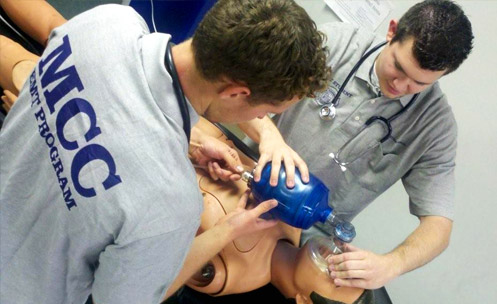
Program Information
Learn more about the Paramedicine program.
General Help
Ask general questions at our support center.
Course Sequence
The Certificate of Completion (CCL) in Paramedicine is a nationally accredited program designed to prepare students to become Paramedics. This program is a formal education in such paramedicine topics as anatomy and physiology, pathophysiology, cardiology, pulmonary, pharmacology, pediatrics, geriatrics hematology, toxicology. Paramedicine builds upon EMT education and includes paramedic scope of practice. Paramedicine is integrated with fire service, law enforcement, ground transport services, flight transport services, search and rescue, hospitals, clinical setting, community paramedicine, and EMS education. There is an Associate in Applied Science (AAS) in Paramedicine available.
Details
Important information you’ll need when applying for admission:
- Field of Interest
- Health Sciences
- Type
- Certificate of Completion (CCL)
- Academic Plan
- Paramedicine (CER)
- Academic Plan Code
- 5990
- Total Credits Required
- 45.5
- Catalog Year
- 2025-2026
- Effective Term
- Fall 2024
- Notes
Students must earn a grade of C or better in all courses within the program.
What You’ll Learn
This pathway map will help you gain the expertise needed to:
- Maintain patient, public, personnel, and personal health, wellness and safety.
- Demonstrate personal behaviors consistent with professional standards.
- Communicate efficiently and effectively with members of diverse populations in a culturally responsive manner.
- Effectively function within a multi-disciplinary healthcare system, recognizing roles, responsibilities and scope of practice.
- Efficiently synthesize and evaluate multiple sources of information.
- Perform comprehensive patient assessment.
- Develop a working differential diagnosis using multiple sources of information.
- Make informed, autonomous decisions in both clinical and uncontrolled settings.
- Guide and support the healthcare team, navigating interpersonal dynamics.
- Effectively manage patients.
Career Opportunities
Successful completion of this certificate may lead to employment in a variety of different occupations and industries. Below are examples of related occupations with associated Maricopa County-based annual median wages* for this certificate. Education requirements vary for the occupations listed below, so you may need further education or degrees in order to qualify for some of these jobs and earn the related salaries. Please visit with an academic advisor and/or program director for additional information. You can click on any occupation to view the detail regarding education level, wages, and employment information.
Emergency Medical Technicians and Paramedics
$33,313 Show expanded career information for Emergency Medical Technicians and Paramedics
Admission Criteria
Students must be current and in good standing with the Arizona Department of Health Services Bureau of Emergency Medical Services-Certified as an Emergency Medical Technician. EMT certification preparatory courses are available at Maricopa County Community Colleges. Contact an academic advisor for details.
Students must complete an application and selection process.
Course Sequence by Term
The following is the suggested course sequence by term. Please keep in mind:
- Students should meet with an academic advisor to develop an individual education plan that meets their academic and career goals. Use the Degree Progress Report Tool in your Student Center to manage your plan.
- The course sequence is laid out by suggested term and may be affected when students enter the program at different times of the year.
- Initial course placement is determined by current district placement measures and/or completion of 100-200 level course and/or program requirements.
- Degree and transfer seeking students may be required to successfully complete a MCCCD First Year Experience Course (FYE) within the first two semesters at a MCCCD College. Courses include FYE101 and FYE103. Course offerings will vary by college. See an academic, program, or faculty advisor for details.
Ready to get started?
Follow one of the options below to get started on your personal career pathway.
Become a Student
Click here for MCC’s easy-to-use Enrollment Steps.
Program Information
Learn more about and find contact information for the Paramedicine program.
General Help
Ask general questions over the phone at 480-461-7400 or via online chat.
Course Area Key
Critical Course = A course that is highly predictive of future success in a pathway.
- SQ = Natural Sciences Quantitative
Disclaimer
Students must earn a grade of C or better for all courses required within the program.
Course Sequence total credits may differ from the program information located on the MCCCD curriculum website due to program and system design.
At Maricopa, we strive to provide you with accurate and current information about our degree and certificate offerings. Due to the dynamic nature of the curriculum process, course and program information is subject to change. As a result, the course list associated with this degree or certificate on this site does not represent a contract, nor does it guarantee course availability. If you are interested in pursuing this degree or certificate, meet with an academic advisor to discuss the requirements at your college for the appropriate catalog year.
View MCCCD’s official curriculum documentation for additional details regarding the requirements of this award (https://aztransmac2.asu.edu/cgi-bin/WebObjects/MCCCD.woa/wa/freeForm11?id=187585).
Previous Catalog Years
The pathway map presented above is for the current catalog year and is the intended pathway map for new students. All previous catalog years for this pathway map are available at the link below.
Previous catalog years for Certificate of Completion (CCL) in Paramedicine



